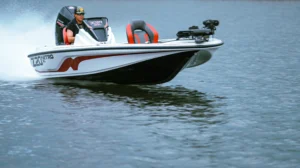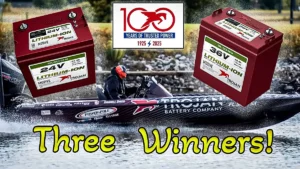Fall is a time where many anglers hang up their fishing rods for a variety of reasons. With the start of school, hunting seasons and football, the lake is often empty. For those anglers looking to bass fish throughout autumn, there’s loads of great fishing opportunities to be had. The summer to fall transition can be difficult for some anglers, however understanding a few key nuances can help you find success this time of year. These include water temperature, water level, lake turnovers and bait migration.
TEMPERATURE CHANGE
Temperature change is likely the first condition change you’ll notice during the summer to fall transition.Where the lake is in the temperature cycle makes a difference in where the fish will be. As temperatures begin to cool, a large number of bass will move to shallower waters. This will disperse fish that have been holding on deep summer haunts, making consistent deep bites harder and harder to come by. Shallow power fishing patterns are often successful this time of year, as many bass are congregated shallow chasing baitfish.
This temperature change not only causes fish to flood the bank, but it also generates a suspended bite as well. The majority of baitfish spend summer months deep in the water column. However as temperatures cool, these baitfish will rise up and float, cruising throughout the water searching for balls of bait. This allows for an exhilarating bite that typically lasts through winter. This will often setup at the mouths of creeks, backs of pockets and any other locations baitfish may congregate.
LAKE TURNOVERS
The next condition change you may notice is lake turnovers. This occurs as surface water temperatures cool to a certain level, causing the cooler water on top to switch with the warmer water below. This can cause a certain depth or portion of the lake to be unfishable. You can detect a lake turnover on your electronics a few diffident ways, but it’s largely shown through disturbance. On side and down imaging, this can be shown through a hard line of disturbance, often staying at a certain depth. This is the same on forward-facing sonar as well, often casting a fuzzy appearance beneath a certain depth.
One of the best ways to combat this turnover is by targeting shallow fish. The summer to fall transition is one of my favorite times to burn down the bank, as most fish have just arrived from out deep. Rivers, channel swings and other shallow structures are all great places to target this time of year. I generally stick with action baits this time of year, however I’ll show down with a jig or Texas Rig once I know fish are in the area.
WATER LEVEL CHANGE
The next change that happens this time of year is the lake drawdown. This is when the lake water level drops to the winter pool, often leaving shallow cover with little to no water. This typically happens further into the fall, and it really limits the type of cover you can fish. Low water levels cause flats and other tapering banks to be virtually un-fishable, making channel swings and other deep locations far more productive. The lack of shallow structure often causes fish to congregate in these deeper areas, often leading to a productive day of fishing.
Bluff walls are another historically productive location this time of year. There’s numerous ways to approach this type of cover, however I primarily stick with three. These include a jig, shallow crankbait and umbrella rig. I use the crankbait for burning down shallow rock and covering lots of water. This is great in muddy water conditions, and topically accounts for numerous big bass this time of year. Some of my favorite shallow crankbaits include the Berkley Frittside 5 and the Rapala DT 6.
I use a jig for targeting laydowns and other types of cover that might be scattered along the bluff wall. Flipping this bait into cracks in brush and other types of irregularities is a great way to generate some giant bites. The umbrella rig is perfect for targeting suspended fish along the bluff. I prefer to use forward- facing sonar in this scenario, throwing my bait at groups of fish scattered around the bluff wall. Some of my favorite umbrella rigs include the Yum Flash Mob Jr. and the Stealth Lures Stealth Rig.
BAIT MIGRATION
The last and arguably most important factor in fall fishing is the bait migration. Throughout the hot summer months, the majority of baitfish reside in 20 to 40 feet, relating to ledges and other types of offshore structure. As water temperatures cool, baitfish move high in the water column, often congregating in certain areas of the lake. The backs of creeks are a historical location where baitfish congregate, however you can find them in numerous locations such as pinch points or channel swings.
The movement of bait directly dictates the location of bass. This is especially true throughout the summer to fall transition, as bass are focused on eating shad this time of year. Paying attention to where this bait is located is a quick way to get dialed in on a bite. I primarily stick with reaction baits this time of year, primarily consisting of spinnerbaits, shallow crankbaits and jerkbaits. I’ve found that matching the hatch typically works best in these scenarios, however there is always a time and place for slow-moving bottom baits.
Locating baitfish can be fairly simple, and it can be done with or without high-end electronics. I like to start by looking for birds such as loons, however you can also look for balls of bait rippling on the surface. Channel swings and bluff walls are typically your best bet during the transition, however electronics allow you to target a few more off the wall locations. Searching for bait balls using forward facing sonar is a great way to catch bass when this is happening. Targeting wolf packs of bass feeding on bait is a consistent way to get bit, and it’s quickly turned into one of my favorite patterns. My favorite presentation for this scenario is a Z-Man Scented Jerk Shadz rigged on a Queen Tackle Tungsten L.S. Jighead.
LEGENDS OF THE FALL
Regardless of where you are in the summer to fall transition, one or more of these scenarios should apply. Cool mornings and an empty lake makes for some fun days of fishing, and there is no better time to hit the lake than right now. If you’re looking to find success during this year’s transition, be sure to focus on these simple tips.
















